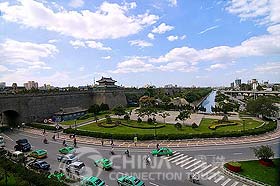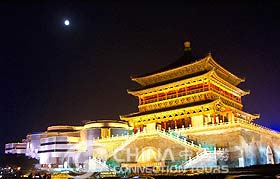
 Xi'an, was called Chang'an in ancient times, and is now the capital of Shaanxi province. It's the political, economic and cultural center of Northwest China. With the development of the travel industry and the implementation of the open door policy, it has become one of the nation's key tourist cities and tourism has become a mainstay in Shaanxi's economy.
Xi'an, was called Chang'an in ancient times, and is now the capital of Shaanxi province. It's the political, economic and cultural center of Northwest China. With the development of the travel industry and the implementation of the open door policy, it has become one of the nation's key tourist cities and tourism has become a mainstay in Shaanxi's economy.
Xi'an is located in the middle reaches of the Yellow River. It holds a key position in the fertile plain between the high loess plateau to the north and the Qinling Mountains to the south. The Qinling Mountain Range is an important geographical divide between northern and southern China and the major watershed of the Yellow and Yangtze Rivers. Xi'an covers an area of 16,808 sq km with a temperate and continental climate, cold and dry in winter and hot in summer. The rainy season comes in July, August and September. The annual mean temperature is 13C with annual precipitation of 604 mm.
Xi'an has a population of six million with 3.5 million in the urban area. People who live here are mainly Han, Hun, Manchu and Mongols. There are more than 700,000 Hun inhabitants in Xi'an. Most of the natives speak local dialect which sounds similar to the mandarin. The government language is mandarin. The main religion in Xi'an is Buddhism.
 Xi'an served as the imperial capital for eleven dynasties. This area has been the site of some of the oldest cities in the world's oldest civilization. Its history begins in the Bronze Age, three thousand years ago, when the people of the Western Zhou dynasty, known for their skilled bronze work, built their capital at Fenghao, a few miles west of Xi'an. When Fenghao was sacked by northwestern tribes, the Zhou Dynasty moved its capital to Luoyang.
Xi'an served as the imperial capital for eleven dynasties. This area has been the site of some of the oldest cities in the world's oldest civilization. Its history begins in the Bronze Age, three thousand years ago, when the people of the Western Zhou dynasty, known for their skilled bronze work, built their capital at Fenghao, a few miles west of Xi'an. When Fenghao was sacked by northwestern tribes, the Zhou Dynasty moved its capital to Luoyang.
In 221 BC the Emperor Qin Shi Huang united Chinese into a single empire, the Qin, with its capital at Xianyang, just north of Xi'an. The succeeding dynasty, the Han, also based its capital there. Han emperors ruled from 206 BC to 220 AD. Nearly contemporary to Imperial Rome, the Han ruled an empire of comparable size and power. Xi'an was the starting point on the Silk Road which was one of the most important arteries of trade and culture in world history.
It was not until 589AD that the Sui Dynasty built a new capital near Xi'an called Da Xingcheng-Great Prosperity City. The Tang Dynasty, which replaced the Han in 618 AD, took over the capital, but changed the face of the city with their own style of architecture. The Tang Dynasty period was a golden age of art, ceramics, calligraphy, painting and poetry. The city of Xi'an's lay-out was taken as a model for the building of many other Chinese cities and for the Japanese capital, Nara. The city was the capital of a great empire and one of the biggest metropolises in the world. There were more than 1 million people living in this magnificent city.
After the fall of the Tang Dynasty, Xi'an went into a long decline. Although it was never again the imperial capital, it still played an important military role in the Ming and Qing Dynasties.

